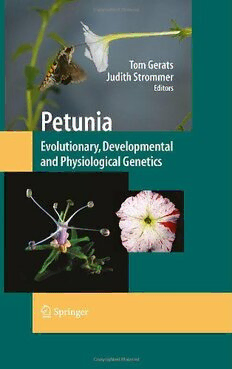
Petunia: Evolutionary, Developmental and Physiological Genetics PDF
464 Pages·2009·10.048 MB·English
Most books are stored in the elastic cloud where traffic is expensive. For this reason, we have a limit on daily download.
Preview Petunia: Evolutionary, Developmental and Physiological Genetics
Description:
In 1984, when the first edition of this monograph was published, Petunia was well-positioned as a classical model system to contribute significantly to the coming explosion in plant molecular biology. Its strength was fostered by years of physiological, biochemical, genetic and cytogenetic research- the contributions of early workers who saw the value and promise of this horticulturally significant representative of the Solanaceae. The present edition encapsulates the state of Petunia-based research a quarter of a century later. It paints a rich portrait of progress, particularly but not exclusively in evolutionary and developmental biology. The wealth of knowledge presented here, and the continued promise of Petunia as a research system, both follow from a combination of that solid early work, the amenability of Petunia to molecular analysis, and the dedication and collegiality of the Petunia research community. All are richly documented in this work.Tom Gerats completed his Ph.D. on Petunia flavonoids and transposons at the University of Amsterdam (1984). He then joined the Genetics Department of the Free University (also in Amsterdam) where a group was formed, headed by Ed Veltkamp, later Jos Mol, to work on the molecular aspects of flavonoid genes. Tom moved to Marc van Montagu’s group in Ghent (Belgium) in 1990, where he continued to work on Petunia as a main system. In 2001 he obtained a chair in Plant Genetics at the Radboud University, Nijmegen. Starting with his work as an undergraduate, he has aimed throughout his career to enhance Petunia’s status as a model system for comparative research.Judy Strommer received B.S. and M.S. degrees from the University of Chicago and a Ph.D. in Molecular Biology from UCLA. She lives with her family in Guelph, Ontario, where she is a Professor of Plant Agriculture at the University of Guelph. She was introduced to Petunia research by Tom Gerats at a meeting of the Genetics Society of America more than 20 years ago. Current research in her laboratory involves analysis of the regulation of anthocyanin production in grape and development of feed-based vaccines, but she remains a devoted fan of Petunia and the research it has inspired.
See more
The list of books you might like
Most books are stored in the elastic cloud where traffic is expensive. For this reason, we have a limit on daily download.
